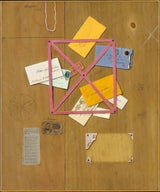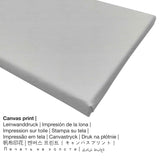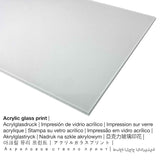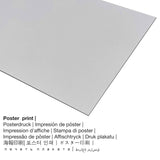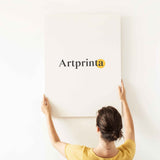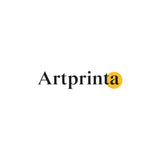William Michael Harnett, 1879 - Akwụkwọ ozi Artist Rack - mbipụta nka mara mma
Ụtụ gụnyere. Mbupu gbakọrọ na ndenye ọpụpụ.
Ihe ebipụta nka ị nwere ike họrọ na:
Nchịkọta nhọrọ ngwaahịa na-enye gị ohere ịhọrọ nha na ihe ị họọrọ. Anyị na-ahapụ gị ka ịhọrọ nha na akụrụngwa ọkacha mmasị gị n'etiti nhọrọ nhazi ngwaahịa ndị a:
- Ihe odide acrylic glass: A glossy acrylic glass print, which is sometimes referenced as a plexiglass print, transforms your favorite original work of art into gorgeous décor. The artwork is being made with modern UV print technology. Our acrylic glass protects your custom fine art print against sunlight and heat for up to 60 years.
- Mbipụta akwụkwọ mmado (ihe kwaaji): The Artprinta poster is a printed cotton canvas paper with a slight surface finish, which reminds the actual version of the work of art. Please bear in mind, that depending on the size of the canvas poster print we add a white margin of something between 2-6 cm round about the print motif, which facilitates the framing.
- Mbipụta nke aluminom: Aluminium Dibond prints are metal prints with an outstanding depth. For the Print On Aluminum Dibond, we print your chosen work of art onto the surface of the aluminum. The white and bright parts of the artwork shimmer with a silky gloss but without glare. Colors are bright and vivid in the highest definition, the details of the print are crisp and clear.
- Kwaaji: A printed canvas, not to be mistaken with an artwork painted on a canvas, is a digital replica printed on an industrial printer. The advantage of canvas prints is that they are relatively low in weight, which implies that it is easy and straightforward to hang your Canvas print without the support of extra wall-mounts. Canvas prints are suited for all types of walls.
Disclaimer: We try what we can in order to describe our products as accurately as possible and to showcase them visually in our shop. Nevertheless, the tone of the printing material and the print result may differ to a certain extent from the representation on the device's screen. Depending on the screen settings and the quality of the surface, colors might not be printed one hundret percent realistically. Considering that our fine art prints are processed and printed manually, there might also be slight discrepancies in the size and exact position of the motif.
Nkọwa zuru oke site na ụlọ ngosi nka (© Nwebiisinka - The Metropolitan Museum of Art - Museumlọ ihe ngosi nka nke Obodo)
This is the earlier of Harnett’s two known “rack” pictures, a subject he and his contemporary John F. Peto had inherited from seventeenth-century Dutch painters. The wood boards of the background, the pink tape of the rack, the cards and envelopes that are tucked into it, and the surrounding paper scraps are all carefully delineated. Curling edges, subtle shadows, and distinctive textures tease the viewer into imagining that all the painted elements are real. A few clues suggest that the canvas was commissioned by someone associated with the Philadelphia firm C. C. Peirson and Sons, which dealt in woolens and hides.
Banyere eserese na aha "The Artist's Letter Rack"
a 19th narị afọ masterpiece e kere site William Michael Harnett in 1879. Ụdị ihe osise ahụ nwere nha ndị a: 30 x 25 n'ime (76,2 x 63,5 cm). Oil on canvas was used by the European artist as the technique for the work of art. Nowadays, the artwork can be viewed in in the digital collection of Museumlọ ihe ngosi nka nke Obodo. Site n'ikike nke: Ụlọ ihe ngosi nka nke Metropolitan, New York, Morris K. Jesup Fund, 1966 (ikikere: ngalaba ọha). Creditline of the artwork: Morris K. Jesup Fund, 1966. On top of that, alignment is in Eserese usoro na nwere akụkụ ruru nke 1: 1.2, meaning that the length is 20% shorter than the width. William Michael Harnett was a painter, whose artistic style can mainly be attributed to Realism. The artist lived for 44 afọ - born in 1848 in Clonakilty, County Cork, Ireland and deceased in 1892.
Data ndabere na ọrụ nka pụrụ iche
| Aha ọrụ nka: | "The Artist's Letter Rack" |
| Nhazi: | sere |
| Okwu mkpokọta: | nkà nke oge a |
| Century: | 19th narị afọ |
| Emepụtara na: | 1879 |
| Ogologo afọ nka nka: | karịa afọ 140 |
| Usoro izizi: | mmanụ na kwaaji |
| Akụkụ nke ọrụ nka mbụ: | 30 x 25 n'ime (76,2 x 63,5 cm) |
| Ụlọ ihe ngosi nka: | Museumlọ ihe ngosi nka nke Obodo |
| Ebe ngosi nka: | New York City, New York, Njikota Obodo Amerika |
| URL webụ: | Museumlọ ihe ngosi nka nke Obodo |
| Ụdị ikike nka: | ngalaba ọha |
| Site n'aka: | Ụlọ ihe ngosi nka nke Metropolitan, New York, Morris K. Jesup Fund, 1966 |
| Ebe kredit nke ọrụ nka: | Morris K. Jesup Fund, 1966 |
Nkọwa edemede
| Nkewa bipụta: | ọmarịcha nka |
| Mmeputakwa: | mmeputakwa n'ụdị dijitalụ |
| Usoro mmepụta: | Mbipụta UV / dijitalụ |
| Ihe ngosi: | emere na Germany |
| Stockdị ngwaahịa: | mmepụta ihe na-achọ |
| A na-atụ aro iji ngwaahịa eme ihe: | ime ụlọ, ihe ndozi mgbidi |
| Ndozi onyonyo: | usoro eserese |
| Njikwa oyiyi: | (ogologo: obosara) 1: 1.2 |
| Oke onyonyo pụtara: | ogologo bụ 20% mkpụmkpụ karịa obosara |
| Nhọrọ dị: | ígwè ebipụta (aluminium dibond), acrylic glass print (nwere ezigbo mkpuchi iko), mbipụta akwa akwa, mbipụta akwụkwọ mmado (akwụkwọ kwaaji) |
| Mbipụta kanvas (akwa akwa na etiti ihe ndọtị) dị iche iche: | 50x60cm - 20x24", 100x120cm - 39x47", 150x180cm - 59x71" |
| Mbipụta iko acrylic (nke nwere ezigbo mkpuchi iko): | 50x60cm - 20x24", 100x120cm - 39x47" |
| Mpempe akwụkwọ mmado (akwụkwọ kwaaji) nha dị iche iche: | 50x60cm - 20x24", 100x120cm - 39x47" |
| Mpempe akwụkwọ Dibony (ihe alumnium) nha dị iche iche: | 50x60cm - 20x24", 100x120cm - 39x47" |
| ụba: | enweghị etiti |
Nkọwa onye nka
| aha: | William Michael Harnett |
| A makwaara dịka: | Harnett William M., prof. harnett, Harnett William, Harnett William Michael, William Michael Harnett, Harnett, w.m. harnett |
| Gender: | nwoke |
| Obodo onye nka: | Irish |
| Ọrụ onye na-ese ihe: | onye na-ese ihe |
| Obodo onye nka: | Ireland |
| nhazi ọkwa: | omenkà nke oge a |
| Ụdị nka: | Ihe ngosi |
| Nwụrụ na afọ nke: | 44 afọ |
| Afọ ọmụmụ: | 1848 |
| Obodo amụrụ: | Clonakility, County Cork, Ireland |
| Nwụrụ n'afọ: | 1892 |
| Ebe ọnwụ: | New York City, New York State, Njikota Obodo Amerika |
Nwebiisinka © | Artprinta.com

